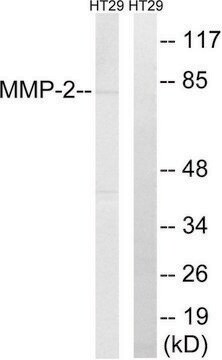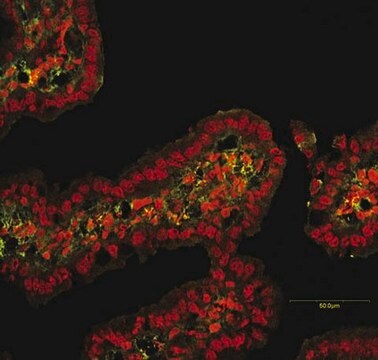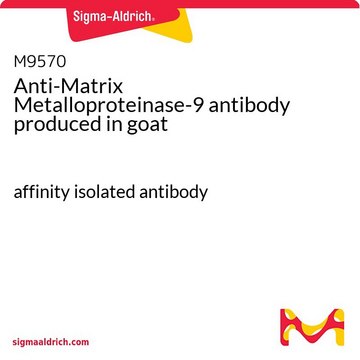AB19016
Anti-MMP-9 Antibody, Catalytic domain
Chemicon®, from rabbit
Synonym(s):
Gelatinase B, 92 kDa Type IV Collagenase
About This Item
Recommended Products
biological source
rabbit
Quality Level
antibody form
purified antibody
antibody product type
primary antibodies
clone
polyclonal
species reactivity
human, mouse, rat
manufacturer/tradename
Chemicon®
technique(s)
immunohistochemistry: suitable
immunoprecipitation (IP): suitable
western blot: suitable
NCBI accession no.
UniProt accession no.
shipped in
wet ice
target post-translational modification
unmodified
Gene Information
human ... MMP9(4318)
General description
MMPs are enzymes implicated in normal and pathologic tissue remodeling processes, wound healing, angiogenesis, and tumor invasion. MMP9, also known as gelatinase B, is a secreted enzyme which degrades the interstitial collagens, types I, II, and III, and is produced by normal alveolar macrophages and granulocytes. The expression of MMP9 increases in Epstein-Barr virus infected lymphoma derived cell lines and may be of significance in typically invasive nasopharyngeal carcinomas.
Specificity
Immunogen
Application
Cell Structure
MMPs & TIMPs
1:1000 dilution of a previous lot was used.
Immunoprecipitation:
1:500 dilution from a previous lot was used. MMP-9 is constitutively produced by some tumor cell lines (i.e., HT1080, HL60, and U937), but not in most quiescent cells and tissues. The phorbol ester TPA stimulates production of MMP-9 in some cell types. MMP-9 levels in culture media (pg/mL) are often below the threshold of detection by standard Western Blotting. The enzyme can be concentrated from culture media by gelatin-agarose affinity chromatography (Goldberg, G.I. et al. J. Biol. Chem. 267, 4583-4591. 1992). This can prevent appearance of a spurious band of antibody binding in the vicinity of 68 kDa displayed by some concentrated media.
Western blot: 1:2,000. Typically 98-95 kDa pro and 92-88kDa active forms are detected as well as breakdown products under fully reduced conditions. Under non-reduced conditions additional bands may be detected because of SDS-stable TIMP and other inhibitor complexes. CC069 is recommended as a positive control.
Immunohistochemistry: 1:100 dilution from a previous lot was used in frozen acetone fixed tissues.
Optimal working dilutions must be determined by end user.
Quality
Western Blot Analysis: 1:1000 dilution of this lot detected MMP-9 on 10 µg of L6 lysates.
Target description
Linkage
Physical form
Storage and Stability
Analysis Note
HL60 cell lysate, U937 cell lysate Lung.
Other Notes
Legal Information
Disclaimer
Not finding the right product?
Try our Product Selector Tool.
Storage Class Code
10 - Combustible liquids
WGK
WGK 2
Certificates of Analysis (COA)
Search for Certificates of Analysis (COA) by entering the products Lot/Batch Number. Lot and Batch Numbers can be found on a product’s label following the words ‘Lot’ or ‘Batch’.
Already Own This Product?
Find documentation for the products that you have recently purchased in the Document Library.
Our team of scientists has experience in all areas of research including Life Science, Material Science, Chemical Synthesis, Chromatography, Analytical and many others.
Contact Technical Service








